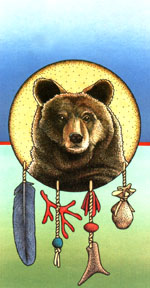
Lessons From Bear
by Linda Pascatore (C) The Gobbler 1999 Autumn Blaze

Lessons From Bear
by Linda Pascatore (C) The Gobbler 1999 Autumn Blaze
Fall is here! The leaves are changing into bright yellows, oranges and reds. There is a cool, crisp smell in the air. Crops are being harvested and garden vegetables are prolific. Apples are ripe on the trees and soon it will be time for a visit to the pumpkin patch. Purple, pink and white asters dot the landscape.In the midst of all this excitement lie reminders of the approaching winter. Vegetation is slowly dying as it changes colors. The days are growing shorter and the nights are both longer and colder. Birds are migrating, and both animals and humans are preparing for the cold, hard winter to come.
The Autumnal Equinox occurs between the 21st and 23rd of September each year. It is the time when day and night are of equal length. This is the balancing point between light and dark, summer and winter. We are moving from the active, physical summertime to a more passive, spiritual time. During the summer most of us spend more time outdoors, school is in recess, workers take vacations, and people socialize more. In winter (at least here in the snowbelt of western New York), students return to their studies, we are more often indoors, and people tend to be more introspective. We are reminded of our own mortality as the vegetation withers and dies. It is a time of psychological as well as physical change.
Many cultures have found parallels between the seasons, the cycles of the day, and the cycles of our lives. Spring is associated with dawn, birth and childhood. Summer is noon, the prime of our lives, active and youthful. Autumn brings sunset, maturity, and fulfillment. Winter is the midnight, time of wisdom, old age and death. Then of course the cycle begins again with Spring, dawn and rebirth.
In our agricultural past, harvest was a crucial time of year for survival during the coming winter. At harvest time the fruits of a hard summer of physical labor were gathered in. Then there was a big harvest celebration. After the festivities, the farmer had to take stock of the bounty and make some tough decisions. The husks had to be burned, the seeds for next year's planting selected, fields either cultivated or left fallow, and the animals chosen for slaughter or breeding.
In current times, most of our harvests are not crops but a project completed, a child well raised, a house repainted, an antique restored, a poem written, a promise fulfilled, or any job well done. We still need to take time to celebrate our harvests. Then we must cast away the husks and discard unfinished projects that we'll never complete. The next phase is the planning; deciding what "seeds" to keep and nurture as future projects. This harvesting process takes time, introspection, and a little dreaming.
According to the Native Americans, autumn is associated with the West and sunset. The gifts of the West are our achievements, goals and dreams. The animal is the bear. He feasts on the summer's bounty, then withdraws from the world into the cave. He sleeps and dreams through the winter.
We can learn from the bear that we also need times of rest and introspection. If we listen to the spirit inside and allow ourselves to dream, we will emerge with clear goals which will lead us to true achievements.
So this Fall, take some time: for celebration of your achievements, rest and renewal, release of old goals and adoption of new ones. Enjoy the warm sunny days of Indian summer, jump in the leaves, watch the sunset, eat apples, drink cider, curl up on a cold night in front of a warm fire and dream!
Home